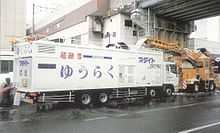Snowmelter
Introduction
Snowmelters have been around for over almost two hundred years.[1] Melting snow artificially helps keep roads, airport tarmacs and other surfaces clear and ready to use.[2] Melting snow is primarily used in areas where trucking snow is not geographically or economically feasible.[3]
Comparison with dumping snow

There are two main barriers to dumping snow, the cost and availability of land, and the cost of trucking snow. The first barrier to dumping snow is the availability of land suitable for dumping. In most urban areas, the cost of land is significant. The average listing for property in New York City is over two million dollars.[4] Therefore, many organizations are forced to either truck, or melt the snow. The second barrier to dumping snow is trucking snow to remote dump sites. The concentration of population in city centres means there is a lack of suitable land to dump the snow. With the increasing trend in the cost of oil,[5] the cost of trucking snow can be prohibitive. Thus, melting it on site by using an industrial snowmelter may be more cost-effective.
Types
There are three main types of snowmelters; submerged combustion, heat exchangers, and resistance heaters.[6] Submerged combustion snowmelters use a flame that is applied to the snow, or a water bath.[7] The flame causes tiny bubbles to form that transfer their heat almost instantly to the bath. Heat exchange and resistance heater type snowmelters are generally installed permanently under driveways, roads and other outdoor surfaces where snow and ice buildup would be undesirable.[8]
Environmental issues
In the past, it was common for organizations that had access to bodies of water to dump snow in lakes, rivers, or oceans. However, much of the snow is contaminated with chemicals and debris that are harmful to the environment if left untreated. Many cities and other government bodies have placed limitations on dumping snow into bodies of water. For instance, the Massachusetts Department of Environmental Protection issued guidelines on how to properly remove snow. In it they state, "As snow melts, road salt, sand, litter, and other pollutants are transported into surface water or through the soil where they may eventually reach the groundwater."[9] They recommend, "Avoid dumping of snow into any waterbody, including rivers, the ocean, reservoirs, ponds, or wetlands. In addition to water quality impacts and flooding, snow disposed of in open water can cause navigational hazards when it freezes into ice blocks."[10]
Proponents for snowmelters claim that these essentially speed up the natural snowmelting process. They discharge the melt water into storm drains and sewer systems where the water is treated and released back into the local water systems.[11] An example of this process is shown in the following video.[12] However they consume substantial amount of energy and the carbon dioxide from the burning flame contributes to global warming.
References
- ↑ http://www.trecan.com/en/con_snowmelter_history.php
- ↑ http://www.trecan.com/en/con_snowmelter_history.php
- ↑ http://www.trecan.com/en/con_snowmelter_history.php
- ↑ http://www.trulia.com/real_estate/New_York-New_York/
- ↑ http://www.oil-price.net/
- ↑ http://www.trecan.com/en/con_snowmelter_history.php
- ↑ http://www.trecan.com/en/con_snowmelter_history.php
- ↑ http://www.heatexchangersonline.com/snowandicemelting.htm
- ↑ http://www.mass.gov/dep/water/laws/snowdisp.htm
- ↑ http://www.mass.gov/dep/water/laws/snowdisp.htm
- ↑ http://www.trecan.com/en/con_snowmelters_faq.php
- ↑ http://www.youtube.com/watch?v=BaVHi9Mq56I
